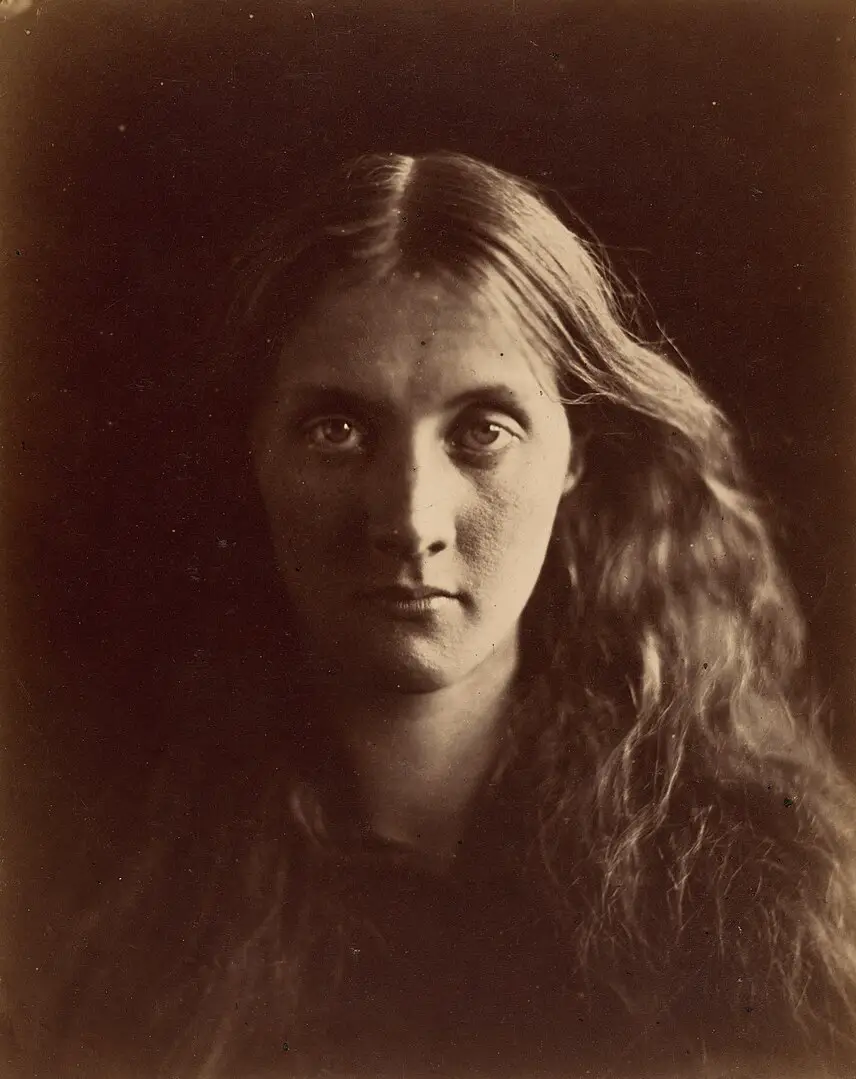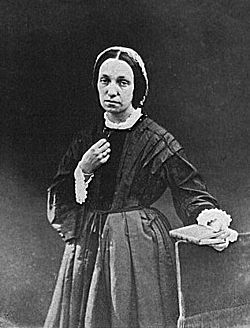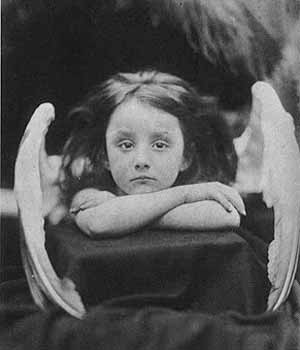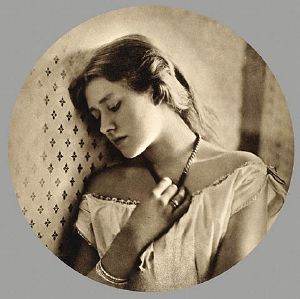Cameron, Julia Margaret
(claim tag) |
|||
| Line 22: | Line 22: | ||
The bulk of Cameron's photographs fit into two categories: closely framed portraits and illustrative allegories based on religious and literary works. In the allegorical works in particular, her artistic influence was clearly [[Pre-Raphaelite]], with far-away looks and limp poses and soft lighting. | The bulk of Cameron's photographs fit into two categories: closely framed portraits and illustrative allegories based on religious and literary works. In the allegorical works in particular, her artistic influence was clearly [[Pre-Raphaelite]], with far-away looks and limp poses and soft lighting. | ||
| + | |||
| + | ===[From Another Website]=== | ||
| + | |||
| + | Cameron was born in Calcutta in 1815. Although educated in France she moved back to India in 1834 when she was nineteen. In 1848 she and her husband moved to England. Cameron was part of a large family, the fourth of ten children, and had a large family of her own. Part of the upper class, Cameron enjoyed a rich life and made the acquaintence of a number of famous people. Her career as a photographer began in 1863 when her husband was away on a trip. To cheer her from her loneliness, her daughter gave her a camera. Cameron began photographing everyone in sight. Because of the newness of photography as a practice, she was free to make her own rules and not be bound to convention. The kinds of images being made at the time did not interest Cameron. She was interested in capturing another kind of photographic truth. Not one dependent on accuracy of sharp detail, but one that depicted the emotional state of her sitter. | ||
| + | |||
| + | Cameron worked with large glass plate negatives. Because she used a negative plate that was large in size, something that was usually used to shoot the landscape, making her images required her sitters to sit still for long periods of time. As this was difficult to do, her images often came out soft and out of focus. Cameron liked the soft focus portraits and the streak marks on her negatives, choosing to work with these irregularites, making them part of her pictures. Although her photographs lacked the sharpness that other photographers at the time aspired towards, they succeeded in conveying the emotional and spiritual aura of the sitter. Cameron's ambition as a photographer was to "secure [for photography] the character and uses of high art by combining real and ideal, and sacrificing nothing of truth by all possible devotion to poetry and beauty." | ||
| + | |||
| + | In 1873 Cameron sent her sister Maria (Mia) Jackson a partially empty photo album, asking her sister to collaborate with her on the project in the years to come by adding images, as she sent them, in the places and the sequence she described. The front part of the album had photographs and portraits Cameron took of her family and friends, both candidly posed as well as acting out staged tableaux. The back half of the album contained images by Cameron's contemporaries like Oscar Gustave Rejlander and Lewis Caroll, as well as numerous photographs of paintings and drawings. | ||
| + | Although at the time Cameron was seen as an unconventional and experimental photographer, her images have a solid place in the history of photography. Her family albums are noteworthy not only as documents of a family history, but they also provide insights into Victorian society. Most of Cameron's photographs are portraits. She used members of her family as sitters and made photographs than concentrated on their faces. She was interested in conveying their natural beauty, often asking female sitters to let down their hair so as to show them in a way that they were not accustomed to presenting themselves. In addition to making stunning and evocative portraits both of male and female subjects, Cameron also staged tableaux and posed her sitters in situations that simulated allegorical paintings. | ||
| + | |||
| + | The Mia Album contained both kinds of images. Amongst the photographs in the album and in the exhibition are some of Cameron's most famous. Included is The Kiss of Peace, a portrait of a mother and child based on the gospel story of the Visitation. In the photograph the child gazes down, while the mother's lips rest casually on her brow. This is a quiet image, one that projects maternal love. Most of Cameron's photographs have a spiritual sensibility, and are peaceful and romantic. The mood is sombre and contemplative. She did not photograph action or care much about backgrounds. It was the essence of the subject that motivated Cameron's photography. | ||
| + | |||
| + | |||
| + | |||
===Portraits=== | ===Portraits=== | ||
Revision as of 22:59, 8 November 2007
Julia Margaret Cameron (June 11 1815 – January 26 1879) was a British photographer. She became known for her portraits of celebrities of the time, and for Arthurian and similar legendary themed pictures.
Cameron's photographic career was short (about 12 years) and came late in her life. Her work had a huge impact on the development of modern photography, especially her closely cropped portraits which are still mimicked today. Her house, Dimbola Lodge, on the Isle of Wight can still be visited.
Early life
Julia Margaret Cameron was born Julia Margaret Pattle in Calcutta, India, to James Pattle, a British official of the East India Company, and Adeline de l'Etang, a daughter of French aristocrats. Cameron was from a family of celebrated beauties, and was considered an ugly duckling among her sisters. For example, each sister had an attribute which she used as a nickname. Her sisters had nicknames like "beauty". Julia's nickname was "talent". [citation needed] This instilled in Julia an obsession with idealized beauty.
Marriage
Julia was educated in France, but returned to India, and in 1838, married Charles Hay Cameron, a jurist and member of the Law Commission stationed in Calcutta who was twenty years her senior. In 1848, Charles Hay Cameron retired and the family moved to London, England. Cameron's sister, Sarah Prinsep, had been living in London and hosted a salon at Little Holland House, the dower house of Holland House in Kensington, where famous artists and writers regularly visited. In 1860, Cameron visited the estate of poet Alfred Lord Tennyson on the Isle of Wight. Julia was taken with the location and the Cameron family purchased a property on the island soon after. They called it Dimbola Lodge after the family's Ceylon estate.
Photography
In 1863, when Cameron was 48 years old, her daughter gave her a camera as a present, thereby starting her career as a photographer. Within a year, Cameron became a member of the Photographic Societies of London and Scotland. In her photography, Cameron strove to capture beauty. She wrote, "I longed to arrest all the beauty that came before me and at length the longing has been satisfied."[1]
Her neighbour on the Isle of Wight, Alfred Lord Tennyson often brought friends to see the photographer.
Cameron was sometimes obsessive about her new occupation, subjects sitting for countless exposures in the blinding light as she laboriously coated, exposed, and processed each wet plate. The results were, in fact, unconventional in their intimacy and their particular visual habit of created blur through both long exposures where the subject moved and by leaving the lens intentionally out of focus. This led some of her contemporaries to complain and even ridicule the work, but her friends and family were supportive and she was one of the most prolific and advanced of amateurs in her time. Her enthusiasm for her craft meant that her children and others sometimes tired of her endless photographing, but it also means that we are left with some of the best of records of her children and of the many notable figures of the time who visited her.
During her career, Cameron registered each of her photographs with the copyright office and kept detailed records. Her shrewd business sense is one reason that so many of her works survive today. Another reason that many of Cameron's portraits are significant is because they are often the only existing photograph of historical figures. Many paintings and drawings exist, but, at the time, photography was still a new, challenging medium for someone outside a typical portrait studio.
The bulk of Cameron's photographs fit into two categories: closely framed portraits and illustrative allegories based on religious and literary works. In the allegorical works in particular, her artistic influence was clearly Pre-Raphaelite, with far-away looks and limp poses and soft lighting.
[From Another Website]
Cameron was born in Calcutta in 1815. Although educated in France she moved back to India in 1834 when she was nineteen. In 1848 she and her husband moved to England. Cameron was part of a large family, the fourth of ten children, and had a large family of her own. Part of the upper class, Cameron enjoyed a rich life and made the acquaintence of a number of famous people. Her career as a photographer began in 1863 when her husband was away on a trip. To cheer her from her loneliness, her daughter gave her a camera. Cameron began photographing everyone in sight. Because of the newness of photography as a practice, she was free to make her own rules and not be bound to convention. The kinds of images being made at the time did not interest Cameron. She was interested in capturing another kind of photographic truth. Not one dependent on accuracy of sharp detail, but one that depicted the emotional state of her sitter.
Cameron worked with large glass plate negatives. Because she used a negative plate that was large in size, something that was usually used to shoot the landscape, making her images required her sitters to sit still for long periods of time. As this was difficult to do, her images often came out soft and out of focus. Cameron liked the soft focus portraits and the streak marks on her negatives, choosing to work with these irregularites, making them part of her pictures. Although her photographs lacked the sharpness that other photographers at the time aspired towards, they succeeded in conveying the emotional and spiritual aura of the sitter. Cameron's ambition as a photographer was to "secure [for photography] the character and uses of high art by combining real and ideal, and sacrificing nothing of truth by all possible devotion to poetry and beauty."
In 1873 Cameron sent her sister Maria (Mia) Jackson a partially empty photo album, asking her sister to collaborate with her on the project in the years to come by adding images, as she sent them, in the places and the sequence she described. The front part of the album had photographs and portraits Cameron took of her family and friends, both candidly posed as well as acting out staged tableaux. The back half of the album contained images by Cameron's contemporaries like Oscar Gustave Rejlander and Lewis Caroll, as well as numerous photographs of paintings and drawings. Although at the time Cameron was seen as an unconventional and experimental photographer, her images have a solid place in the history of photography. Her family albums are noteworthy not only as documents of a family history, but they also provide insights into Victorian society. Most of Cameron's photographs are portraits. She used members of her family as sitters and made photographs than concentrated on their faces. She was interested in conveying their natural beauty, often asking female sitters to let down their hair so as to show them in a way that they were not accustomed to presenting themselves. In addition to making stunning and evocative portraits both of male and female subjects, Cameron also staged tableaux and posed her sitters in situations that simulated allegorical paintings.
The Mia Album contained both kinds of images. Amongst the photographs in the album and in the exhibition are some of Cameron's most famous. Included is The Kiss of Peace, a portrait of a mother and child based on the gospel story of the Visitation. In the photograph the child gazes down, while the mother's lips rest casually on her brow. This is a quiet image, one that projects maternal love. Most of Cameron's photographs have a spiritual sensibility, and are peaceful and romantic. The mood is sombre and contemplative. She did not photograph action or care much about backgrounds. It was the essence of the subject that motivated Cameron's photography.
Portraits
Cameron's sister ran the artistic scene at Little Holland House, which gave her many famous subjects for her portraits. Some of her famous subjects include: Charles Darwin, Alfred Lord Tennyson, Robert Browning, John Everett Millais, William Michael Rossetti, Edward Burne-Jones, Ellen Terry and George Frederic Watts. Most of these distinctive portraits are cropped closely around the subject's face and are in soft focus. Cameron was often friends with these Victorian celebrities, and tried to capture their personalities in her photos.
Photographic illustrations
Cameron's posed photographic illustrations represent the other half of her work. In these illustrations, she frequently photographed historical scenes or literary works, which often took the quality of oil paintings. However, she made no attempt in hiding the backgrounds. Cameron's friendship with Tennyson led to his asking her to photograph illustrations for his Idylls of the King. These photographs are designed to look like oil paintings from the same time period, including rich details like historical costumes and intricate draperies. Today, these posed works are sometimes dismissed by art critics. Nevertheless, Cameron saw these photographs as art, just like the oil paintings they imitated.
Later life
In 1875 the Camerons moved back to Ceylon (now Sri Lanka). Julia continued to practice photography but complained in letters about the difficulties of getting chemicals and pure water to develop and print photographs. Also, in India, she did not have access to Little Holland House's artistic community. She also did not have a market to distribute her photographs as she had in England. Because of this, Cameron took fewer pictures in India. These pictures were of posed Indian natives, paralleling the posed pictures that Cameron had taken of neighbours in England. Almost none of Cameron's work from India survives. Cameron died in Ceylon in 1879.

Legacy
Cameron's niece Julia Prinsep Stephen née Jackson (1846–1895) wrote the biography of Cameron which appeared in the first edition of the Dictionary of National Biography, 1886.
- Stephen, L. (1886). Dictionary of national biography: vol. VIII. Burton — Cantwell. London: Smith, Elder, & Co.
Julia Stephen was the mother of Virginia Woolf, who wrote a comic portrayal of the "Freshwater circle" in her only play Freshwater. Woolf edited, with Roger Fry, a collection of Cameron's photographs:
- Woolf, V., & Fry, R. E. (1926). Victorian photographs of famous men & women. New York: Harcourt, Brace.
However, it was not until 1948 that her photography became more widely known when Helmut Gernsheim wrote a book on her work:
- Gernsheim, H. (1948). Julia Margaret Cameron; her life and photographic work. Famous photographers. London: Fountain Press; distributed in the USA by Transatlantic Arts, New York.
Further reading
- Cameron, J. M. P. (1875). Illustrations by Julia Margaret Cameron of Alfred Tennyson's Idylls of the King and other poems.
- Cameron, J. M. P. (1889). Fragment of exhibition catalogue, Annals of my glass house by Julia Margaret Cameron.
- Cameron, J. M. P. (1973). Victorian photographs of famous men & fair women. Boston: D.R. Godine.
- Cameron, J. M. (1975). The Herschel album: an album of photographs. London (2 St Martin's Place, WC2H 0HE): National Portrait Gallery.
- Cameron, J. M., & Ford, C. (1975). The Cameron Collection: an album of photographs. Wokingham: Van Nostrand Reinhold for the National Portrait Gallery.
- Cameron, J. M. P., & Weaver, M. (1986). Whisper of the muse: the Overstone album & other photographs. Malibu: J. Paul Getty Museum.
- Cameron, J. M. P. (1994). For my best beloved sister, Mia: an album of photographs by Julia Margaret Cameron : an exhibition of works from the Hochberg-Mattis collection organized by the University of New Mexico Art Museum. Albuquerque: The Museum.
External Links
- Julia Margaret Cameron Trust
- The official National Media Museum print website containing many Julia Margaret Cameron prints
- George Eastman House photography collection - 163 selected images
- Julia Margaret Cameron exhibit at the National Gallery of Victoria, Australia
- Inventory of the Julia Margaret Cameron Family Papers, ca. 1777-1940, including full names of individuals, their identity, and nicknames used within the correspondence
- Julia Margaret Cameron - Photographer in Focus. Photography. Victoria and Albert Museum. Retrieved 2007-08-25.
de:Julia Margaret Cameron et:Julia Margaret Cameron es:Julia Margaret Cameron fr:Julia Margaret Cameron it:Julia Margaret Cameron ja:ジュリア・マーガレット・カメロン no:Julia Margaret Cameron pl:Julia Margaret Cameron th:จูเลีย มาร์กาเร็ต คาเมรอน



